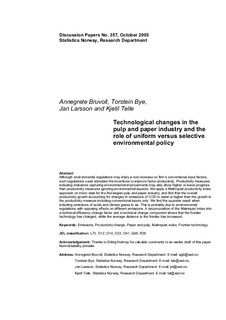| dc.contributor.author | Bruvoll, Annegrete | |
| dc.contributor.author | Bye, Torstein | |
| dc.contributor.author | Larsson, Jan | |
| dc.contributor.author | Telle, Kjetil | |
| dc.date.accessioned | 2011-11-24T15:46:26Z | |
| dc.date.available | 2011-11-24T15:46:26Z | |
| dc.date.issued | 2003 | |
| dc.identifier.issn | 1892-753x | |
| dc.identifier.uri | http://hdl.handle.net/11250/180511 | |
| dc.description.abstract | Abstract:
Although environmental regulations may imply a cost increase on firm's conventional input factors,
such regulations could stimulate the incentives to improve factor productivity. Productivity measures
including indicators capturing environmental improvements may also show higher or lower progress
than productivity measures ignoring environmental aspects. We apply a Malmquist productivity index
approach on micro data for the Norwegian pulp and paper industry, and find that the overall
productivity growth accounting for changes in emissions of COD to water is higher than the growth in
the productivity measure including conventional inputs only. We find the opposite result when
including emissions of acids and climate gases to air. This is probably due to environmental
regulations with opposing effects on different emissions. A decomposition of the Malmquist index into
a technical efficiency change factor and a technical change component shows that the frontier
technology has changed, while the average distance to the frontier has increased.
Keywords: Emissions, Productivity change, Paper and pulp, Malmquist index, Frontier technology | no_NO |
| dc.language.iso | eng | no_NO |
| dc.publisher | Statistics Norway, Research Department | no_NO |
| dc.relation.ispartofseries | Discussion Papers;No. 357 | |
| dc.subject | Pulp and paper industry | no_NO |
| dc.subject | Technological changes | no_NO |
| dc.subject | Environmental regulations | no_NO |
| dc.subject | Emissions | no_NO |
| dc.subject | Malmquist index | no_NO |
| dc.subject | Norway | no_NO |
| dc.subject | JEL classification: L73 | no_NO |
| dc.subject | JEL classification: O12 | no_NO |
| dc.subject | JEL classification: O14 | no_NO |
| dc.subject | JEL classification: O33 | no_NO |
| dc.subject | JEL classification: O41 | no_NO |
| dc.subject | JEL classification: Q48 | no_NO |
| dc.subject | JEL classification: R38 | no_NO |
| dc.title | Technological changes in the pulp and paper industry and the role of uniform versus selective environmental policy | no_NO |
| dc.type | Working paper | no_NO |
| dc.subject.nsi | VDP::Social science: 200::Economics: 210::Economics: 212 | no_NO |
| dc.source.pagenumber | 22 s. | no_NO |
